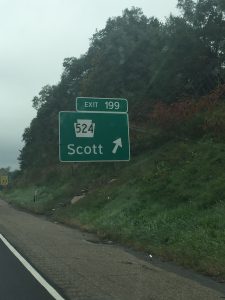Knicks Win Big in Court, and on Court
Last week ended with big takings news for Knicks in both Pennsylvania and New York. In New York, the Knicks professional basketball team “took” former Duke University star R.J. Barrett with the third pick in the NBA draft. Barrett is thought by many to have been the best all around prospect in the draft, and the Knicks are hoping that “taking” him will help them win big on the basketball court in the future.

Township of Scott, as seen from I-81 in northeastern PA
Hours later, Rose Mary Knick, a Pennsylvania resident, won in court – winning a 5-4 decision from the United States Supreme Court which held that she could sue her local town in federal court for “taking” her private property rights, where she had alleged that the town’s “taking” of her property without compensating her violated the Takings Clause of 5th Amendment to the United States Constitution.
The parallels between these two events – a taking by or from a Knick involving a court – seemingly end there, unless the basketball star “RJ” is able to don the number “5” on his new Knicks jersey, in tribute to the 5th Amendment that formed the basis of Rosemary Knick’s “big win”. But regardless of whether these recent decisions remain connected in any way in the future, both are important to constitutional law scholars, to property rights attorneys and advocates, and to long-suffering New York Knicks professional basketball fans.
In the Supreme Court decision, Knick v. Township of Scott, the high Court overruled a 1985 precedent from Williamson County Regional Planning Commission v. Hamilton Bank of Johnson City, 473 U.S. 172 (1985), which held that a property owner whose property has been taken by a local government agency cannot file a federal takings claim in federal court based upon a violation of his or her 5th Amendment rights until a state court has first adjudicated that claim under state law. The problem with Williamson County, according to the majority opinion in Knick, is that it creates an untenable Catch-22: the property owner “cannot go to federal court without going to state court first; but if he goes to state court and loses, his claim will be barred in federal court”. Slip Op. at p. 2. As a result, the Knick court solved the Catch-22 by overruling Williamson County and by holding that a “property owner has an actionable Fifth Amendment takings claim [in federal court without first going to state court] when the government takes his property without paying for it.” Id. In support of its decision, the Knick majority, authored by Chief Justice Roberts, held that Williamson County was not only “wrong”, but also that its reasoning was “exceptionally ill-founded” and “conflicted” with decades of takings jurisprudence. Slip Op. at pp. 20-21. Justices Thomas, Alito, Gorsuch and Kavanaugh joined the Chief Justice in his opinion, which announced that it was restoring takings claims to “the full-fledged constitutional status the Framers envisioned when they included the Clause among the other protections in the Bill of Rights”. Slip Op. at p. 6. Justice Thomas filed a short concurring opinion, which stated that the “sue me” approach to the Takings Clause was unworkable because the Fifth Amendment did not merely provide a damages remedy to an owner willing to “shoulder the burden of securing compensation” when private property is taken – as Williamson County suggested – but rather the clause provides that an exercise of eminent domain is invalid “unless the government pays just compensation before or at the time of its taking”. Concurring Op. at 2.
Justice Kagan authored a dissenting opinion, joined by Justices Ginsburg, Breyer and Sotomayor. The dissent submits that the Takings Clause does not require compensation for a taking to be made “previous to a taking” so long as an adequate means of providing for a “reasonably just and prompt ascertainment and payment of the compensation” exists, noting that property rights are ordinarily regulated at the local, not federal level. Justice Kagan’s stinging dissent states that the majority opinion “smashes a hundred-plus years of legal rulings to smithereens” by requiring that a government taking private property for public purposes must pay compensation at the time of the taking or in advance. Dissenting Op. at p. 6. Furthermore, the Kagan dissent submits that, even if the Williamson County decision is “unworkable”, it should have been followed as binding precedent upon the Court under the doctine of stare decisis – which holds that prior decisions are the foundation of the “rule of law”. In so doing, the dissent suggests that the failure to recognize (potentially bad) law as precedential is a sign of things to come from the high Court in the future – that other issues will be decided going forward and decided based upon the will of the majority, instead of basing decisions on the law. Dissenting Op. at 16-18. But, as the majority opinion specifically reasoned, the doctrine of stare decisis is “at its weakest” when the Court is interpreting the Constitution, which is the highest law of our land, and which was done in overruling Williamson County. In addition, the Court noted that the factors to be considered in deciding whether to overrule a past decision – including the quality of the decision’s reasoning, its workability and consistency with related decisions, and reliance on the decision – were all evaluated and determined to warrant the overruling in Knick. Slip Op. at 20-23. As a result, the majority found that the dissent’s assertions regarding stare decisis were “extreme” and, therefore, simply misguided or wrong. Slip Op. at 23.
The dissent suggests that there will be much debate – indeed, significant media coverage has already commenced this debate – about the potential politicization of the Knick opinion, and concern over whether the Court’s decision to overrule one decision is just the tip of the iceberg. Does Knick signal that virtually every prior decision of the Court is now up for grabs and due for a change, or does the foundation of this recent opinion restore faith in the separation of powers created by our Constitution? The three branches of government are supposed to provide checks and balances against each other to assure that our liberties, rights and privileges as Americans are properly and fairly protected and administered. What Knick changes is a process which had evolved since Williamson County was decided in 1985, and which allowed state and local legislative branches of government to take property, potentially in violation of Constitutional law, without affording the aggrieved party with a realistic or meaningful way to allow the judicial branch of government to review whether that legislative act is authorized or prohibited by the law. That untenable outcome is what Knick changes, and now gives hope to parties that a federal court – which interprets federal law – will be available to interpret allegations that their fundamental federal Constitutional property rights have been violated, instead of virtually eliminating the chances of having a federal constitutional decided by a federal court, which is the Catch-22 that Williamson County presented.
Kudos to Rose Mary Knick (and her counsel) for this big property rights win, which may change the landscape of takings cases for years to come. And congratulations and best of luck to the New York Knicks for taking a player who they and their fans hope will change the landscape of professional basketball, just as Knick has changed the law.








